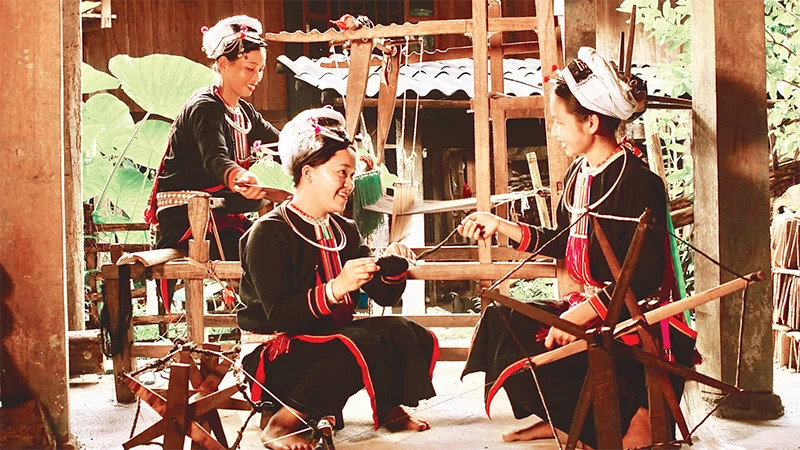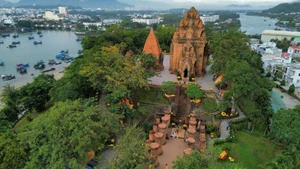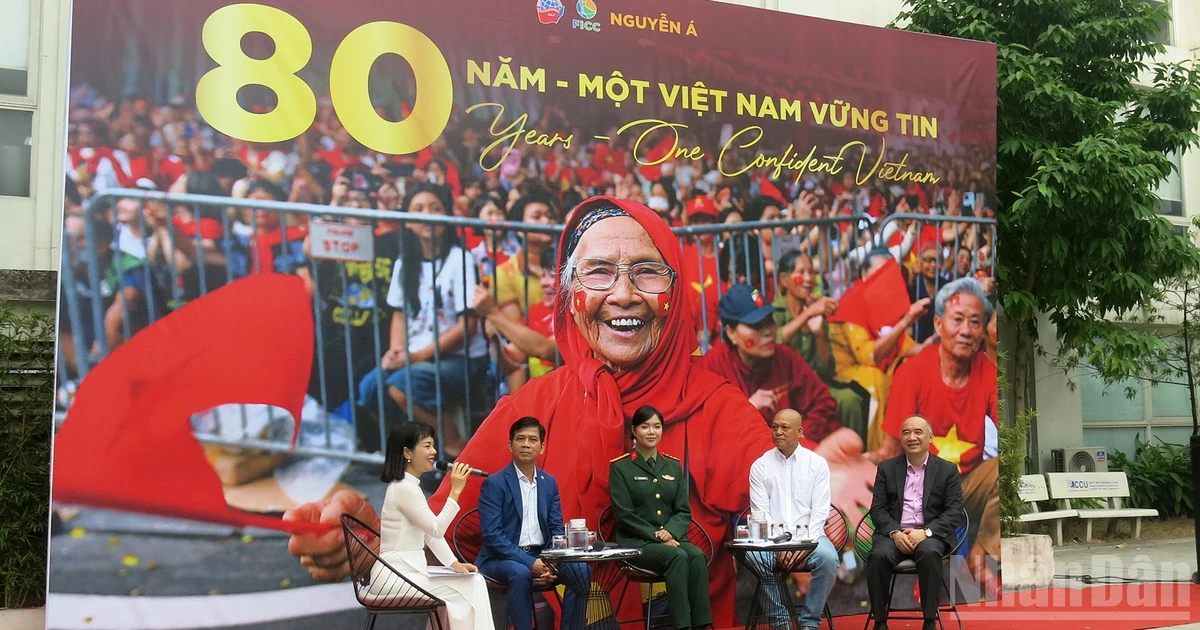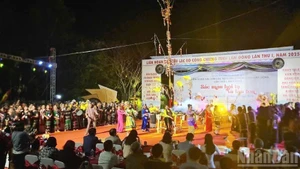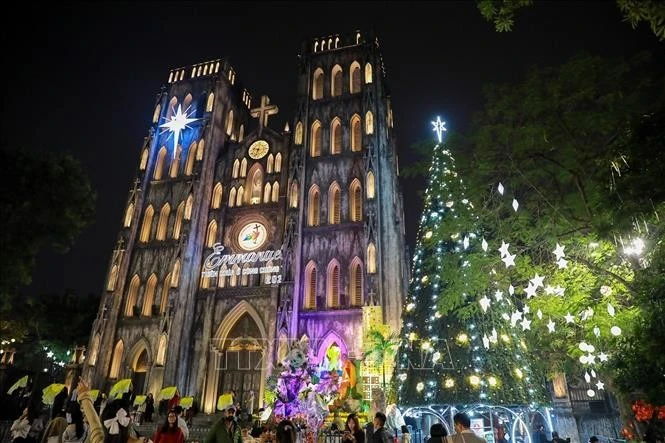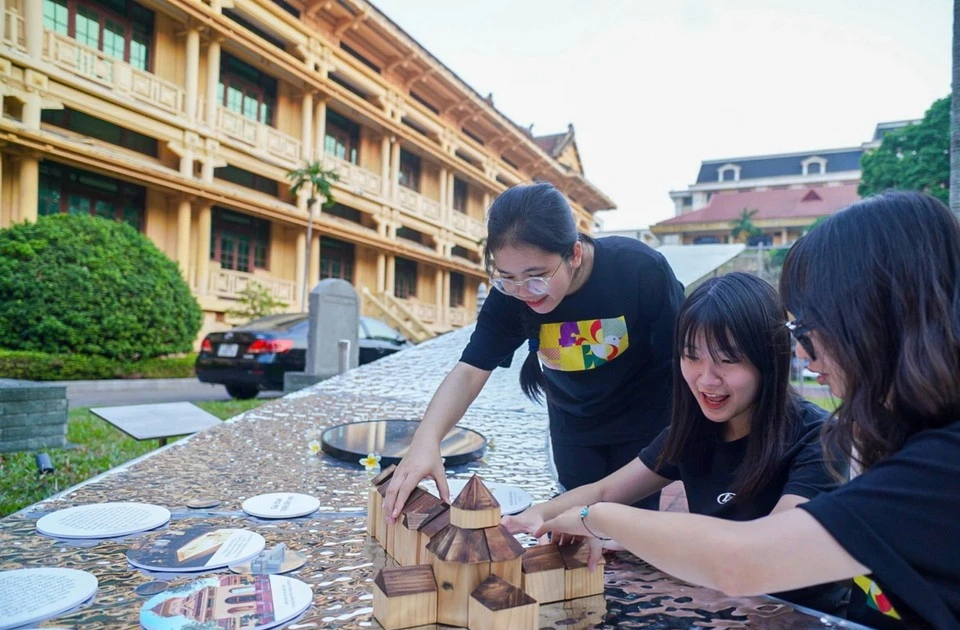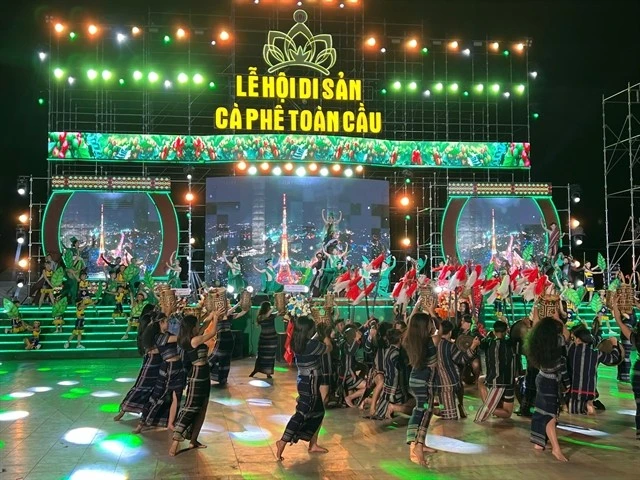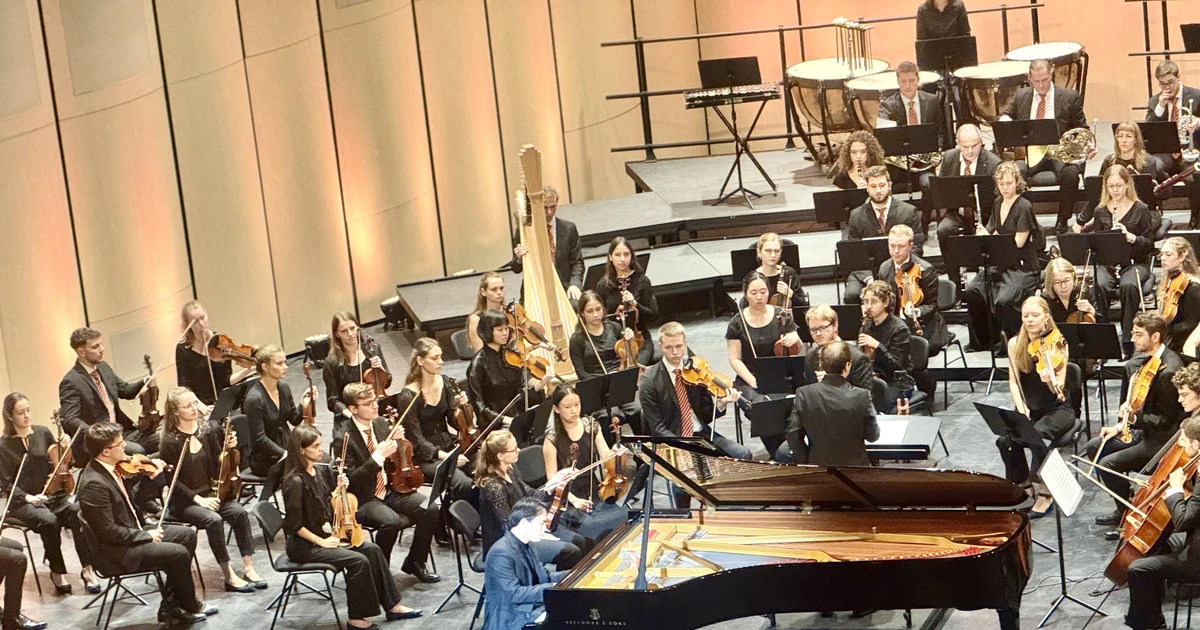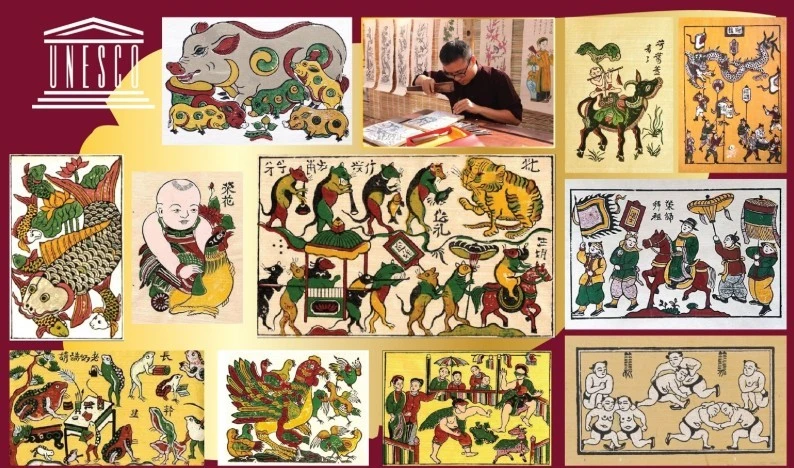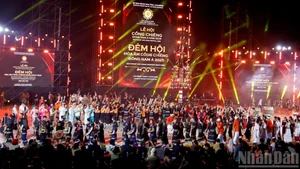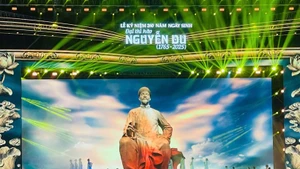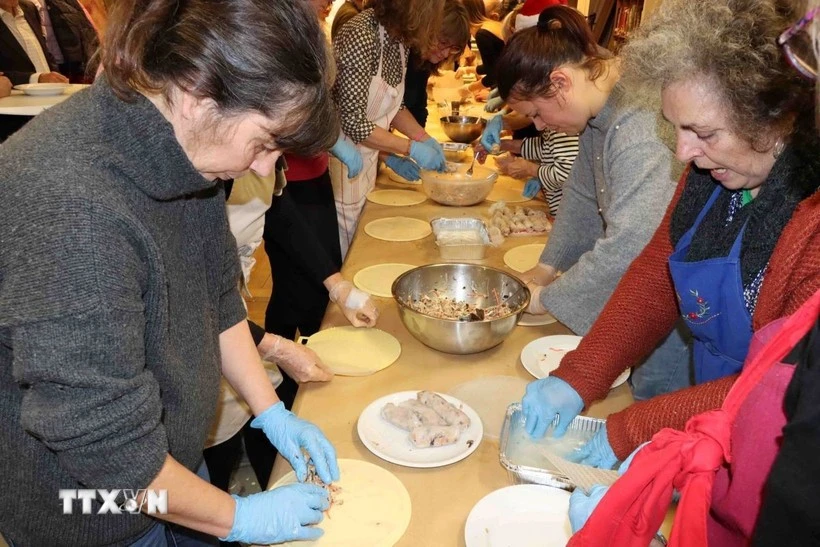Upon arriving at Khau Dang, we walked along the winding concrete paths and met children who innocently pointed toward the terraced fields and said: “In spring, many beautiful flowers bloom here.”
Unified in preserving cultural identity
As we ventured further, we realised that this place offers more than just mountains and trees, it also has a gentle stream. Further along, we saw resilient water wheels, tirelessly bringing in harvests, accompanied by the soothing melody of nature.
“You can walk from one village to another without fear of getting lost, the people from all the villages are like brothers,” said village head Hoang Van Thanh, in his simple and sincere manner, making our steps even more joyful and eager.
Life for the people in Khau Dang depends entirely on 7 ha of agricultural land, with the main crops being corn, rice, and short-term fruit trees. The village’s water supply for daily use comes from a source 5 km away, high up in the mountains, providing an abundant flow of fresh water.
Almost every household here has a garden where they grow seasonal vegetables. The lush, vibrant green vegetable beds represent the bountiful land. Being closely tied to the mountains and forests, the people of this area have acquired a lot of knowledge about using medicinal plants from the ancient forests on the mountains for healing.
Visitors to this village will discover a special herbal drink made from tea leaves (a type of leaf that is roasted and boiled to drink), a unique leaf of the village that is not available in markets. This tea is used to warm the body, especially when the weather changes.
Under the shade of trees, large, sturdy stilt houses stand silently. The dark brown yin-yang tile roofs, which have aged with time, reflect stories of the past. It is evident that over the years, the San Chi people in Khau Dang have made great efforts to preserve and honour their traditional cultural values despite the strong impact of the market economy.
From the stilt house of artisan Hoang Van Cau, we gazed upon the view of the commune centre below the majestic high mountains. In his gentle voice, the artisan, passionate about traditional crafts, enthusiastically shared stories about village bonds, the unity and love among the villagers, and their deep respect for their ethnic culture, which has been passed down from their ancestors. The current generation of Khau Dang continues to safeguard and pass on these cultural treasures. For example, they maintain the daily practice of wearing traditional clothing and weaving, a process involving over 30 intricate steps. Through the traditional weaving techniques of the San Chi people, the fabric, though seemingly thin, is incredibly durable. Today, five households in the village still practice this labour-intensive and time-consuming traditional weaving craft.
What makes Khau Dang even more captivating is the rich spiritual and cultural life of its people, which adds vibrant and warm colours to the landscape.
Artisan Hoang Van Cau proudly shared that the Cap Sac ritual (a rite of passage) has been passed down from generation to generation by the San Chi people in Khau Dang. This ceremony marks the coming of age for San Chi boys, recognising them as responsible adults capable of making important decisions for their families and clans. Although the Cap Sac ceremony is elaborate and requires extensive preparation, it continues to be preserved and is practiced whenever a boy in the family reaches maturity. This ceremony is also a prerequisite for the young men to participate in the “Mask dance”, a traditional male folk dance performed during significant San Chi rituals, such as the full-month ceremony for newborns, the Cap Sac ceremony, weddings, or harvest festivals.
The “Mask dance” usually involves six to eight participants, with two main dancers wearing wooden masks, accompanied by several others dressed in colourful costumes, dancing to the rhythm of drums and gongs.
In addition to this unique dance, the people of Khau Dang are also known for their ‘sinh co’ songs, which are love ballads sung by the San Chi people. These melodies lift the villagers’ spirits and provide an opportunity for young men and women to meet and get to know each other through music and song.
Currently, the village has a folk singing club with 10 members who regularly practice and perform during festivals, holidays, and important local events.
Developing community-based tourism
When Hoang Van Mon’s family welcomed guests from afar, their home suddenly became livelier and cozier than usual. The fragrant aroma of sticky rice filled the air, and when the round brass pot by the stove was opened, it released the aroma of enticing food.
We gathered around the blazing fire, above which smoked meat slabs were gradually drying and turning golden. Villagers came together to help prepare meals and host the guests. Almost all the elderly and women wore traditional ethnic clothing. Although they were reserved with words, their gentle gestures and kind eyes conveyed their warmth and hospitality.
After a sincere invitation from the host, we all sat together for a meal. One dish after another was served: bamboo-tube meat, grilled fish, free-range chicken, boiled bamboo shoots, fresh herbs, all accompanied by fragrant homemade leaf-fermented wine. Amid the laughter and toasts, traditional “Luon” songs were sung passionately by the women. The atmosphere became more and more lively, and the conversation grew closer, filled with warmth and human connection.
The beauty of this place is partly due to nature, but also thanks to the unity and cooperation of the villagers.
Village chief Hoang Van Thanh shared that the village of Khau Dang began developing a community-based tourism model a few years ago. The Pac Nam District provided resources to improve transportation, electricity, and social welfare infrastructure. The villagers are highly conscious of preserving their ethnic cultural identity and beliefs in daily life and during traditional festivals. Previously, most households relied on farming, and their economic situation was difficult. Therefore, when the initiative to develop the village into a community tourism destination was introduced, the residents enthusiastically signed up to participate. With the support from local authorities, families began renovating their homes, making them clean and welcoming for visitors. Overcoming the initial unfamiliarity, the San Chi people, who had only known farming, began learning, practicing, and doing tasks such as communication, cooking, renovating their homes, promoting tourism on social media, growing organic vegetables, and raising local livestock to serve visiting tourists.
“We chose Khau Dang to develop as a community-based tourism village because it has rich natural and cultural potential. The San Chi ethnic group here has many distinctive customs and traditions. The younger generation of the village has progressive thinking about economic development while maintaining and promoting their ethnic cultural identity,” said Ha Viet Phuong, Chairman of the People’s Committee of Boc Bo Commune.
In recent years, the 30a Programme, the Household business support project, and other integrated funding sources have helped make the village more modern while improving transportation. Nearly 4 km of the 5m-wide main road has been paved with concrete.
Thanks to its convenient location and accessible transportation, visitors can explore the village by car, motorbike, or bicycle. It is expected that Khau Dang Village will receive around 10 billion VND in investment from Project 6 under the National Target Programme for Socio-Economic Development in Ethnic Minority and Mountainous Areas. If approved, this investment will be a significant resource for the people of Khau Dang to preserve their traditional cultural values while developing community-based tourism.
Alongside cultural preservation, Khau Dang will adopt a new appearance while retaining its rich identity. Traditional stilt houses will be preserved, renovated, and reinforced. Sacred spaces and traditional living areas will be kept intact.
The villagers will have a roughly 205-m2 community house where they can organise cultural activities, sports, entertainment, and other community gatherings.
The house will showcase traditional cultural artifacts, photo collections of daily life, and the rituals and festivals of the San Chi people. There will also be a stall displaying and promoting OCOP products from the local area and Pac Nam District for tourists.
Khau Dang is making its first steps toward developing community-based tourism, drawing visitors with its natural beauty, strong local identity, and the collective efforts of its people.
